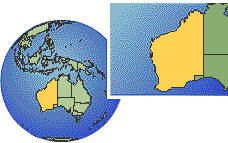Part 2: The Bear Grylls Kimberley Experience
or ‘How To Get Lost Following The Sun’

There was once an amusing TV episode of Bear Grylls where he was in the Kimberley region of Western Australia. He pointed the 12 of his analogue watch towards the sun and declared North to be half way between the 12 and the hour hand.
However, this method is subject to 4 major problems, for which we now issue a Confusion Alert!
Confusion #1: Time Zones

If you put a wood stick in the ground, it will have its shortest shadow length when it is solar noon, local time and at any point along the same degree of longitude. The sun appears to travel 360 degrees around our Earth each day (Galileo would disagree…!), which is 15 degrees of arc per hour. With this knowledge, anyone could construct a sun dial.
With the advent of train schedules in the 19th century, time zones were invented because of the need to keep standardised time (and probably because of the lack of sun dials!). Because the Kimberley region is part of the Australian state of Western Australia, it’s clocks are based on the capital Perth’s time. Perth’s longitude is 115 degrees East. Broome, the largest town in the Kimberley, is 122 degrees East, and the region extends eastward some 700 km (i.e. 7-8 degrees of longitude).

Because of time zones, pointing the 12 of a clock towards the sun in the Kimberley may produce an error of between 7 and 30 degrees in direction depending on your latitude. In fact all locations in Western Australia that are east of Perth (which is most of them), will have varying degrees of error the further east you travel.
In small geographical areas like the United Kingdom, this error is less significant, but in a state like Western Australia that takes up a third of the Australian continent, these errors can be very significant.
Confused…? read on for more!
Confusion #2: Daylight Saving time.
 If Western Australia adopted daylight saving of 1 hour for the Kimberley region alone, it may bring local sun dial time and clock time 1 hour closer together, given that 1 hour forward represents 15 degrees eastward (or about 1600 km/1038 miles at the equator, less at the latitude of the Kimberleys). However Western Australia does not have Daylight Saving for the reasons above – most locations in the state are east of it.
If Western Australia adopted daylight saving of 1 hour for the Kimberley region alone, it may bring local sun dial time and clock time 1 hour closer together, given that 1 hour forward represents 15 degrees eastward (or about 1600 km/1038 miles at the equator, less at the latitude of the Kimberleys). However Western Australia does not have Daylight Saving for the reasons above – most locations in the state are east of it.
Confusion #3: Height of the sun in the sky

The height of the sun is also a problem. For example, people near Brisbane, Australia (latitude 27 degrees south) complain that during most of the day, from at least November through February, the sun is too high in the sky to accurately point the numeral 12 of the clock, even if you could correct for time zones. Hopefully this might save some who try to rely on Bear Grylls’ clock method.
Next: Part 3 – Confusion #4: The variable latitude of the Sun’s path
